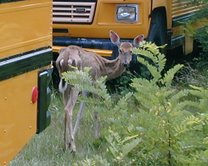
Marked weight loss afflicts deer with Chronic Wasting Disease. Photo: Wisconsin Department of Natural Resources
By Sarah Coefield
Nov. 19, 2009
The best medicine for diseased deer is the business end of a rifle, according to wildlife experts managing the species. And it’s inoculation time.
With hunting season in full swing, conservation officials across the Great Lakes region are relying on hunters to thin the massive herd and slow the spread of disease.
At more than 7 million strong, the region’s white tail deer herd is largely healthy, but there are small pockets of disease.
Chronic wasting disease, a debilitating illness that infects deer and elk, first arrived in Wisconsin in 2001. The next year it spread to Illinois and later popped up in New York in 2004 and Michigan in 2008.
Wisconsin and Illinois host most of the infected deer in the Great Lakes. Wildlife managers have identified 257 cases of chronic wasting disease in Illinois since 2002. But with nearly 1,200 cases, Wisconsin has more diseased deer than all the other Great Lakes states combined.
The disease is a slow killer, said Davin Lopez, the chronic wasting disease project leader for the Wisconsin Department of Natural Resources.
A deer may look healthy throughout the first two years of its illness, but when symptoms appear they come on quickly. An infected deer shows marked weight loss, excessive salivation, disorientation and a lack of coordination, Lopez said. “Once it’s in the final stages, the last several months of the disease, it’s pretty apparent there’s something wrong with the deer.”
And there can be only one ending, he said. Death.
Chronic wasting disease is transmitted by deer-to-deer contact, so the disease spreads faster when deer congregate, Davin said.
Most management strategies limit the gathering of deer groups by banning baiting and feeding. And they encourage hunters to shoot does to thin the herd.
Wisconsin officials work to curtail the spread of infected deer from the lower third of the state where they are clustered. The agency employs special hunting seasons in the disease area, sharpshooters who thin the herd and require that hunters in the disease area shoot an antlerless deer before going after a prize buck. Hunters also cannot move whole deer carcasses out of the disease area, although cut and wrapped meat, clean skulls and finished taxidermy heads can be removed.
The public isn’t always thrilled about the high deer mortality that accompanies the agency’s methods, Davin said. “There’s a lack of awareness, acceptance of what the long term ramifications of (the disease) could be,” he said. “Fifty years down the road it could have a significant impact on the populations. There is an unwillingness to sacrifice for something so far down the road.”
While the disease has popped up across the Great Lakes region, other states have not faced Wisconsin’s containment problem. Chronic wasting disease in Michigan has so far been limited to a single infected deer on a deer farm. New York hasn’t seen a new case in years, said Gordon Batcheller, a wildlife biologist with the New York Department of Environmental Conservation. Still, the states have management plans in action. “Now, like Wisconsin and Michigan and the other Great Lakes states, it’s just something we live with now and have to continually control for,” Batcheller said.